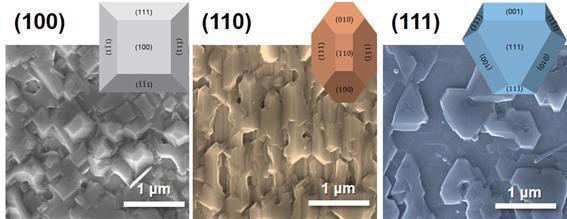Jan 12 2021
All-solid-state batteries—the next-generation batteries—can concurrently enhance the capacity and stability of present-day lithium batteries.
 Scheme of exposed crystal facets of cubic structures with (100), (110), and (111) orientations. Image Credit: Korea Institute of Science and Technology.
Scheme of exposed crystal facets of cubic structures with (100), (110), and (111) orientations. Image Credit: Korea Institute of Science and Technology.
When non-flammable solid electrolytes and cathodes are used in all-solid-state batteries, they significantly decrease the risk of catching fire or exploding under an external impact or high temperatures and promote high-energy-density, which is two times that of regular lithium batteries.
It is believed that all-solid-state batteries will become a game-changer in the energy storage device and electric vehicle markets. But in spite of these benefits, solid electrolytes have low ionic conductivity, deteriorate rapidly, and have a high interfacial resistance that collectively decrease the life and performance of batteries, thereby reducing their commercialization.
The Korea Institute of Science and Technology (KIST) has now announced that the research group of Dr Sang-baek Park from the Center for Energy Materials Research, in association with the research group of Professor Hyun-jung Shin from Sungkyunkwan University, has created a revolutionary material design approach that can resolve the issue of high interfacial resistance between the cathode and the solid electrolyte, which prevents the commercialization of all-solid-state batteries.
Exceptional physical phenomena take place at the interface in which two varied substances meet. The atoms at the interface are different from the atoms present within the bulk of a substance—which hold hands with other types of atoms around themselves and create stable bonds—and are likely to create a different arrangement of atoms. These atoms at the interface do not contain the neighboring atom of the same substance on one side.
A phenomenon takes place in all-solid-state batteries that have a solid electrolyte- solid electrode interface. This phenomenon disrupts the arrangement of atoms and restricts the transfer of charge, thus boosting resistance and expediting deterioration.
Techniques of coating a suitable material on the surface of the electrolyte and the cathode or embedding an intermediate layer are presently being investigated to resolve the above-stated issue. But this considerably lowers the overall energy density and activity of the batteries and also increases the costs.
Hence, to solve these issues, the joint research team from KIST and Sungkyunkwan University first methodically detected the crystal structure of the material that has a direct impact on the solid interface.
The team subsequently used epitaxial film technology (a kind of semiconductor manufacturing technology) to create a thin film along the direction, where the substrate crystals were formed, and eventually obtained cathode films that have different exposed crystal planes under different conditions.
The researchers also thoroughly examined the impact of the exposed crystal plane on the interface between the cathode material and the solid electrolyte but disregarded other factors, like contact area and particle size, that could influence the outcome.
The outcomes indicated that the closely-packed structure of the exposed crystal plane suppressed the leakage of the transition metal from the cathode material into the solid electrolyte, enhancing the stability of the all-solid-state battery.
Moreover, when the crystal interface was organized in parallel with the direction of the electron movement, the orientation of electrons and ions along the crystals was not suppressed, leading to decreased resistance and better output.
This means that improving the cathode material itself by increasing the density of the crystal plane and adjusting the direction of the interface between the crystals can ensure high performance and stability.
Dr Sang-baek Park, Center for Energy Materials Research, Korea Institute of Science and Technology
“We plan to accelerate the development of all-solid-state battery materials by overcoming the instability of the solid electrolyte and solid cathode interface and imparting improved ion-charge exchange characteristics through this study, which has investigated the mechanism of all-solid-state battery degradation,” added Dr Park.
The study was performed as a crucial KIST project with the financial support of the Ministry of Science and ICT (MSIT). The study results were reported in the latest issue of Nano Energy (IF: 16.602, the highest rating of 4.299% by JCR)—an international journal in the area of nanotechnology.
Journal Reference:
Lee, S., et al. (2021) Nano-interface engineering in all-solid-state lithium metal batteries: Tailoring exposed crystal facets of epitaxially grown LiNi0.5Mn1.5O4 films. Nano Energy. doi.org/10.1016/j.nanoen.2020.105480.